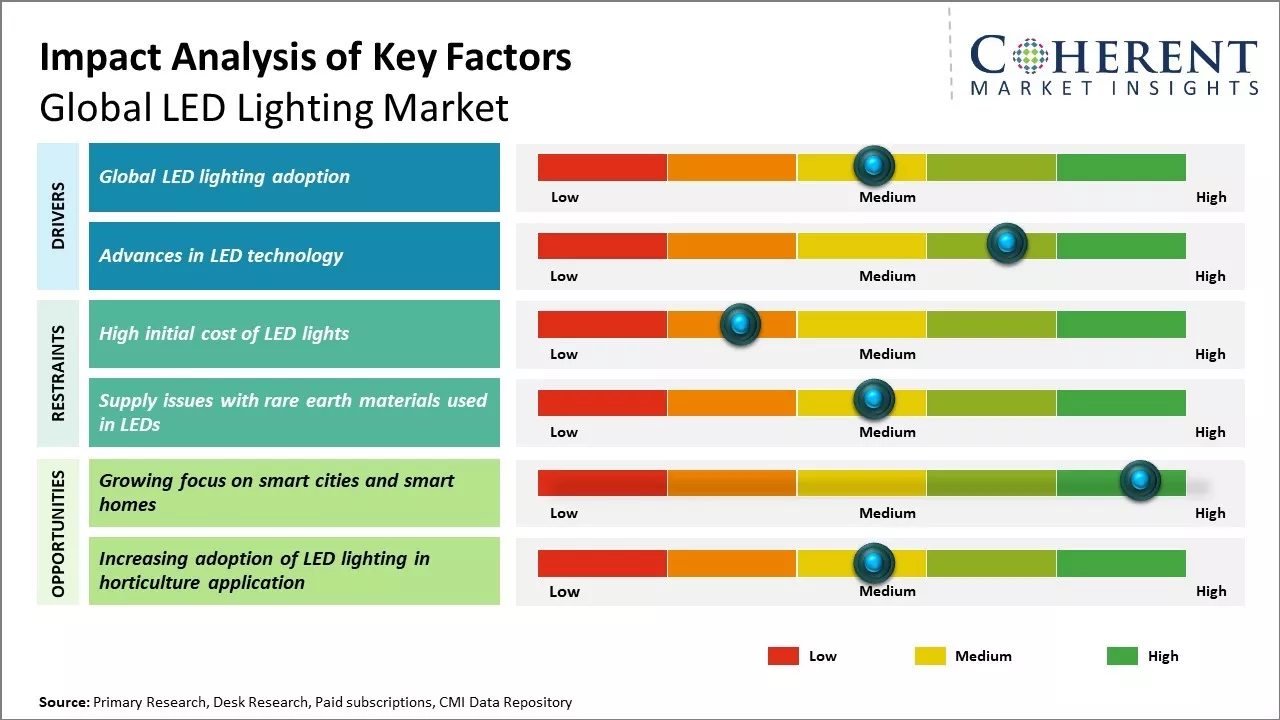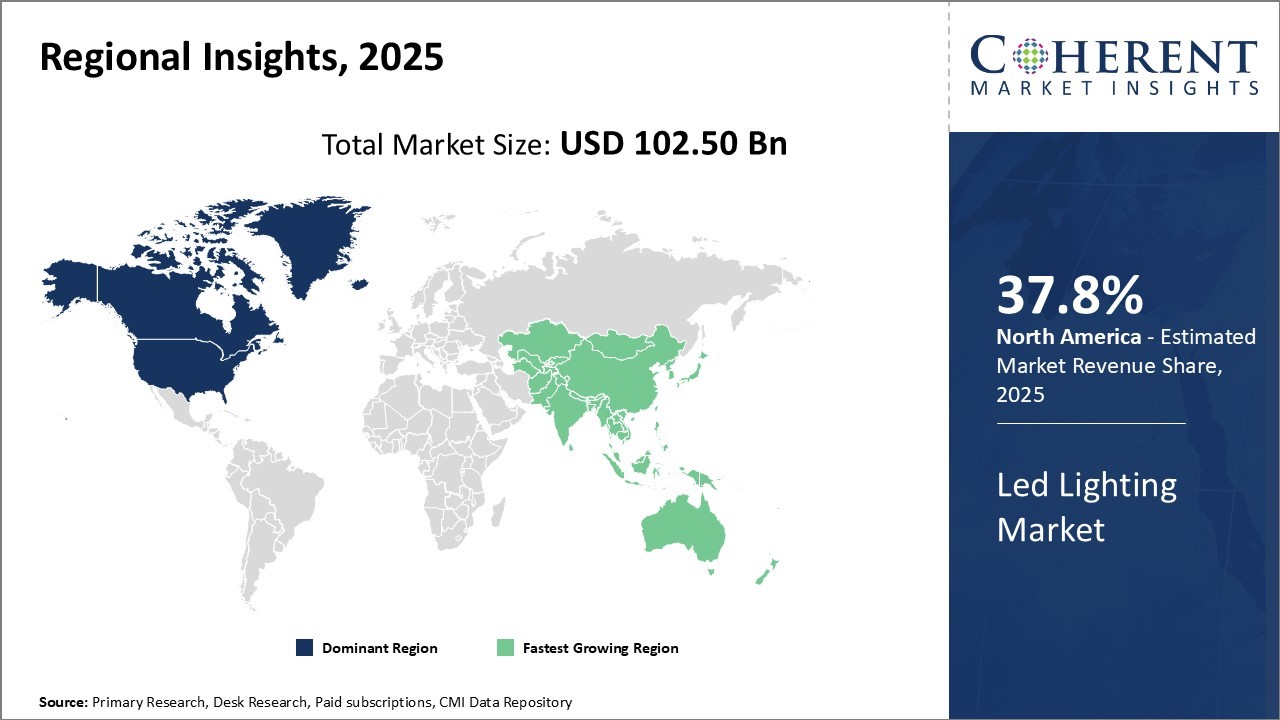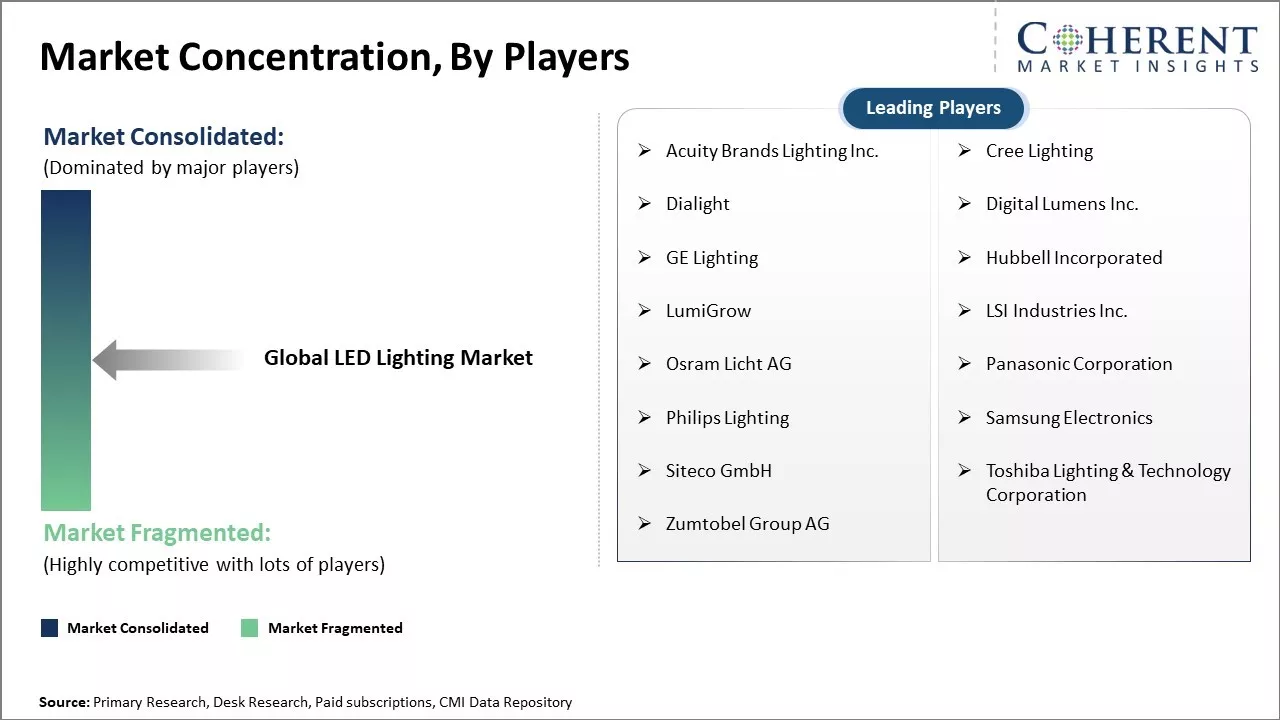The global LED lighting market is estimated to be valued at USD 102.50 Bn in 2025 and is expected to reach USD 228.16 Bn by 2032, exhibiting a compound annual growth rate (CAGR) of 12.1% from 2025 to 2032.

To learn more about this report, Download Free Sample
The rise in the LED lighting market is driven by advancements in smart lighting technologies, and increasing LED demand has also accelerated adoption across residential, commercial, and industrial sectors.
|
Current Events |
Description and its impact |
|
Technological Innovations and Market Expansion |
|
|
Industry-Specific Patent and Production Shifts |
|
Uncover macros and micros vetted on 75+ parameters: Get instant access to report
AI enables intelligent control of LED lighting systems through automation and machine learning. Systems can learn user preferences, adapt to daily routines, and optimize lighting based on occupancy, time of day, or natural light levels—enhancing comfort and energy efficiency.
In January 2025, Signify, a smart lighting company, unveiled a major upgrade to the Philips Hue ecosystem with innovative features and accessories designed to transform home lighting, entertainment, and security. Leading the launch is Philips Hue’s first generative AI assistant, integrated into the Hue app, which creates personalized lighting scenes tailored to the user’s mood, occasion, or style.
Between November 2023 and October 2024 (TTM), India exported a total of 13,318 LED light shipments, reflecting the country’s ongoing presence in the global LED lighting market. These exports were facilitated by 1,568 Indian exporters and catered to 2,899 international buyers across various markets.
In terms of product type, luminaires are expected to contribute 57.3% share of the market in 2025, owing to their widespread usage in commercial settings. Luminaires offer versatile and targeted lighting solutions that are well-suited for commercial applications. Their ability to direct light precisely where it is needed makes them highly energy efficient for use in office spaces, retail stores, warehouses, and other commercial facilities. Compared to lamps, which provide ambient lighting, luminaires allow commercial operators to balance illumination and energy usage by focusing light only on work areas. This has facilitated broader LED adoption among commercial customers seeking to reduce lighting costs.
Additionally, luminaires provide commercial customers with flexibility in installation and replacement. Various troffer, downlight, and strip style luminaires can be easily installed in new or existing commercial ceilings and surfaces. This simplifies upgrades to LED fixtures without the need for electrical work or construction. Luminaires also have longer operational lifespans than lamps, reducing maintenance needs for commercial operators. Their modular, replaceable designs allow individual luminaires to be swapped out over time rather than complete luminaire systems. This lowers the investment needed for re-lamping or retrofitting.
Commercial real estate trends have further boosted luminaires demand. Open office plans, now commonplace, rely heavily on directional luminaires to provide adequate task lighting. Meanwhile, co-working office spaces heavily utilize suspended and freestanding luminaires to create adaptable, non-permanent lighting designs. Warehouses increasingly use high-bay luminaires on walls and ceilings for optimized product illumination. Overall, the commercial emphasis on functionality, energy efficiency, and flexibility has cemented luminaires as the leading product type within the LED lighting industry. For instance, Wipro offers a range of LED luminaries, including the Inform Range with in Sync™, which features human-centric lighting technology that mimics natural sunlight. This is further accelerating the LED lightening market demand.
In terms of application, indoor is expected to contribute a 64.1% share in 2025 due to ongoing LED upgrades in residential settings. Homeowners are increasingly replacing traditional bulbs and fixtures with LED alternatives as part of lifestyle and design-focused renovations. Interior LED solutions address multiple household priorities. Their improved lighting quality and adjustable spectrum meet aesthetic preferences for task and accent lighting. Energy savings become a greater concern as power bills rise, driving the adoption of LED lamps, downlights, and luminaires.
Portability and ease of installation aid indoor LED penetration. Consumers can easily test LED offerings in single rooms before full conversions. Plug-and-play LED lamps replicate traditional bulb formats while providing energy reduction. Hardwired downlights and strips blend seamlessly into renovated ceilings and surfaces. Growing product lines tailored to residential needs, like decorative wall sconces and adjustable recessed cans, remove complexity barriers. Brand partnerships see LED kits bundled with new appliances, furnishings, and building materials. Overall, renovations give homeowners an accessible entry point to indoor LED upgrades as part of lifestyle-focused home improvements. This fuels ongoing gains for the indoor segment. For instance, Inventaa has launched Oxana 3W LED COB spotlight, which is a sleek and energy-efficient spotlight designed for recessed installation, making it ideal for accent lighting in the living rooms, bedrooms, or hallways.
In terms of end-use, residential is expected to contribute a 42.9% share to the LED lighting market in 2025 due to public and private sector initiatives centered around street and outdoor applications. Many cities and municipalities face aging high-pressure sodium streetlight infrastructure in need of energy-efficient replacements. LED street lighting solutions provide compelling return on investment through reduced energy and maintenance costs over luminaire lifecycles exceeding 25 years. Large-scale streetlight conversions supported by federal grants and sustainability mandates drive residential LED volumes.
Complementing public programs, property developers install LED streetlights at new housing projects for lower ongoing costs passed to homeowners’ associations. Rising wealth in developing nations stems from larger residential developments adopting smart, connected lighting systems from inception. Meanwhile, suburban neighborhoods move toward LED retrofits through grassroots initiatives and rebate opportunities. Outdoor LED lighting upgrades gain traction as "curb appeal" is prioritized among affluent homeowners.
Beyond streetlights, growth in smart home technology penetrates residential outdoor applications. Motion-triggered floodlights, pathway fixtures, and landscape spots increasingly use Power over Ethernet-powered LED modules integrated into broader smart home ecosystems. The coming 5G networks empower next-generation connected lighting, optimizing energy efficiency based on weather, daylight, and user behavior patterns at community scales. In totality, multiple tailwinds boost residential as a key end-use for LEDs globally going forward. Apart from this the growing penetration towards at home LED therapy is escalating the LED lightning market share. In January 2025, Heirloom Beauty unveiled its groundbreaking 7-Wavelength LED Light Therapy Mask—an FDA-approved device designed to revolutionize at-home skincare. Delivering a powerful 110 mW/cm², the mask uses precision-engineered wavelengths across seven therapeutic colors to effectively target a wide spectrum of skin concerns, including acne, inflammation, and uneven tone.

To learn more about this report, Download Free Sample
North America has established itself as the dominant player in the global LED lighting market. The region is expected to account for 37.8% of the market share in 2025. The region is home to several big names in the LED lighting industry such as GE Lighting, Acuity Brands, and Hubbell Lighting which have been innovating and introducing new LED lighting solutions at a rapid pace. This has helped North America gain significant expertise and experience in LED lighting technology and stay ahead of the curve. With rising environmental awareness, energy efficiency standards such as ENERGY STAR have driven large-scale adoption of LED lights across various sectors like commercial, residential, industrial, and outdoor in North America. Moreover, the region has a strong culture of early adoption for new technologies, which has further augmented the LED lighting demand.
Another key factor for North America's dominance in the LED lighting market is its robust manufacturing base. Major players have set up large-scale production facilities in the region to cater to both domestic as well as international markets. This has strengthened North America's control over the global LED lighting supply chain. The manufacturing presence also allows players to closely track the latest trends and timely modify their portfolio. This responsiveness to shifting market needs and new opportunities has helped North America solidify its leading position in the LED lighting industry. For instance, the American company Cree LED is known for its performance LED solutions. Cree continues to innovate in the LED space, likely introducing new products in areas like smart lighting and outdoor applications. Their products cover Xamp LEDs, J Series LEDs, and High Brightness LEDs.
Asia Pacific has emerged as the fastest-growing market for LED lighting globally. China particularly stands out and is rapidly catching up to North America. With massive infrastructure development and an urbanization drive, LED lighting finds extensive applications across various new construction projects in China. This alone has opened huge growth avenues. Moreover, the massive size of the Chinese LED lighting market, coupled with government initiatives like the Greenlight Program to push solid-state lighting, is a big boost.
Other Asian countries like India and Japan are also embracing LED lights at a swift pace to save energy costs and commit to sustainability goals. For instance, Syska has announced its collaboration with Google for the launch of the Google Home Mini combo in India. With this partnership, Syska will be bundling its Smart LED bulbs along with a Google Home Mini combo pack.
The growth of the United States LED lighting market is fueled by federal energy-efficiency regulations and rebate programs that encourage the adoption of low-energy lighting. Increasing demand for smart lighting solutions in commercial and residential sectors is also boosting market expansion. For instance, US LED, a top provider of long-life LED lighting, has launched its new Lighting as a Service (LaaS) program, Light Now™. This offering allows customers to upgrade to LED lighting with no upfront costs. This is further propelling the LED lighting market share.
The rise in India’s LED lighting market is driven by the government initiatives like UJALA and Smart Cities Mission, promoting energy-efficient lighting. Rising urbanization and infrastructure lighting. Rising urbanization and infrastructure development have accelerated demand in residential, commercial, and industrial sectors. For instance, Halonix launched India’s first “UP-DOWN GLOW” LED bulb, offering different lighting modes for various needs, including brightness without eye strain and soft illumination. Additionally, declining LED prices and increasing consumer awareness about energy-saving are fueling market growth.

To learn more about this report, Download Free Sample
| Report Coverage | Details | ||
|---|---|---|---|
| Base Year: | 2024 | Market Size in 2025: | USD 102.50 Bn |
| Historical Data for: | 2020 To 2024 | Forecast Period: | 2025 To 2032 |
| Forecast Period 2025 to 2032 CAGR: | 12.1% | 2032 Value Projection: | USD 228.16 Bn |
| Geographies covered: |
|
||
| Segments covered: |
|
||
| Companies covered: |
Acuity Brands Lighting Inc., Cree Lighting, Dialight, Digital Lumens Inc., GE Lighting, Hubbell Incorporated, LumiGrow, LSI Industries Inc., Osram Licht AG, Panasonic Corporation, Philips Lighting, Samsung Electronics, Siteco GmbH, Toshiba Lighting & Technology Corporation, Zumtobel Group AG |
||
| Growth Drivers: |
|
||
| Restraints & Challenges: |
|
||
Uncover macros and micros vetted on 75+ parameters: Get instant access to report
LED lighting has seen a significant rise in demand over the past decade. Factors such as performance, energy efficiency, and longer lifespan compared to traditional lighting are contributing to the increased adoption of LEDs across commercial and residential applications. Government policies promoting energy-efficient lighting to reduce electricity consumption and carbon footprint have further boosted the LED lighting market. Additionally, improving living standards and rising disposable income in developing nations have increased consumer spending on smart lighting systems. Key players introducing innovative and cost-effective products will continue to support the market growth in the coming years. However, high initial installation costs remain a challenge, especially in price-sensitive markets.
The rapid adoption of smart technologies in cities and homes around the world is projected to significantly boost opportunities in the global LED lighting market in the coming years. The rising introduction of smart LED lighting is also propelling the LED lighting market revenue. In May 2025, Xiaomi launched its new Smart LED Bulb (White and Color) in Germany for €12.99 (around $15). The bulb offers 16 million colors using RGB, warm white, and cool white LEDs. Users can choose from 10 preset lighting modes—like Christmas, Fireplace, Jungle, and Ocean—or customize their own via the Xiaomi Home app. As urbanization increases globally, many cities are implementing smart infrastructure and solutions to improve connectivity, energy efficiency, and sustainability. LED lighting is a crucial component of these smart city initiatives as it allows for the remote monitoring and management of public lighting networks. Cities are able to reduce energy consumption and costs through intelligent LED lighting systems that can be controlled centrally and dim or brighten automatically based on outdoor conditions and occupancy.
The rising concern over energy efficiency and sustainability has been a major driver for the adoption of o lighting solutions across the globe. Various countries have implemented stringent regulations mandating the use of energy-efficient lighting products in a bid to curb greenhouse gas emissions and reduce energy consumption. LED lights consume up to 90% less energy as compared to traditional incandescent bulbs and last 25 to 50 times longer. This translates to significantly lower operating costs for consumers and is boosting the popularity of LEDs. Manufacturers are innovating to develop smarter and more powerful LED light bulbs that deliver superior light quality equivalent to conventional lights. There is a growing preference among consumers as well as commercial establishments like offices, malls, and factories to upgrade their lighting infrastructure with LED fixtures for the long-term savings on electricity bills and maintenance costs. Governments across regions have set targets to replace outdated lighting with LED and are providing various financing schemes and subsidies to encourage the widespread installation of LED lighting solutions.
For instance, in May 2023, Zumtobel launched a new line of luminaires featuring high-accuracy positioning (HAP) technology integrated with Internet of Things capabilities. These advanced lighting solutions are designed to enable smart analytics and optimization in logistics, retail, and industrial applications.
Advancements in LED Technology
The LED lighting market has benefited tremendously from continuous technological improvements that have made LED lights more affordable and appealing over the years. Manufacturers have dramatically lowered the price of LED bulbs while simultaneously enhancing their performance capabilities. Earlier, LED lamps used to be big and expensive but now highly compact and powerful LED components are available at throwaway prices. Significant advancements have been made in materials science to develop LED chips that deliver whiter and more natural shades of light. Light uniformity and color rendering capabilities of modern LED lights are now at par with conventional bulbs. The development of integrated LED modules or arrays that combine driver circuit, heatsink and diodes into neat lighting packages has simplified installation and product design. Wireless controls, smart home integrations, and adaptive dimming features are also being incorporated by innovative players. These ongoing technological strides in the areas of optics, packaging, and semiconductor materials have equipped LED lights with competitive illuminating abilities to satisfy various lighting needs while slashing electricity consumption. The LED technology trajectory points towards greater energy efficiency, higher lighting quality, and lower costs in the future, ensuring stellar growth prospects.
Share
Share
About Author
Raj Shah is a seasoned strategy professional with global experience, from strategy to on-the-ground operational improvements. In last 13 years, he has executed number consulting projects focused on consumer electronics, telecom and consumer-internet business leading multiple long-term engagements towards mobilizing and executing on break-through strategy - leading to tangible sales results. Raj is also acting as a strategy consultant for one of the leading online hyper local service providers in India, contributing to their growth through critical strategic decisions. Raj usually spends time after office in talking to the passionate entrepreneurs, regardless of their funding status.
Missing comfort of reading report in your local language? Find your preferred language :
Transform your Strategy with Exclusive Trending Reports :
Frequently Asked Questions
Joining thousands of companies around the world committed to making the Excellent Business Solutions.
View All Our Clients